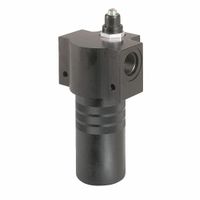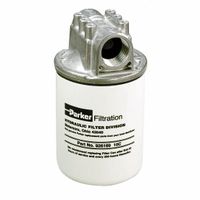Call +(254) 703 030 000 / 751 483 999 / 721 704 777
- Home
- Hydraulics
- Hydraulic Filtration
- In Line Hydraulic Filters
.....Read More
Frequently Asked Questions
What is the purpose of an in-line hydraulic filter?
The purpose of an in-line hydraulic filter is to remove contaminants from hydraulic fluid as it circulates through a hydraulic system. These contaminants can include particles such as metal shavings, rubber, dirt, and other debris that can enter the system during operation or maintenance. By filtering out these impurities, the in-line hydraulic filter helps to protect the hydraulic components, such as pumps, valves, and actuators, from wear and damage.
In-line hydraulic filters are strategically placed within the hydraulic circuit to ensure that the fluid is cleaned before it reaches sensitive components. This placement is crucial for maintaining the efficiency and longevity of the hydraulic system. Clean hydraulic fluid reduces the risk of component failure, minimizes downtime, and extends the service life of the system.
Additionally, in-line hydraulic filters contribute to maintaining optimal system performance. Contaminants in the hydraulic fluid can lead to increased friction, heat generation, and energy loss, which can degrade system efficiency. By ensuring that the fluid remains clean, the filter helps maintain consistent performance and reduces the likelihood of unexpected breakdowns.
In summary, the primary purpose of an in-line hydraulic filter is to ensure the cleanliness of hydraulic fluid, thereby protecting system components, enhancing performance, and extending the overall lifespan of the hydraulic system.
How often should in-line hydraulic filters be replaced?
In-line hydraulic filters should typically be replaced every 1,000 to 2,000 hours of operation, or as specified by the equipment manufacturer. However, several factors can influence this interval, including the operating environment, the type of hydraulic system, and the quality of the hydraulic fluid used.
In harsh or dirty environments, filters may need more frequent replacement due to increased contamination. Conversely, in cleaner environments, the interval might be extended. It's crucial to monitor the pressure drop across the filter; a significant increase indicates that the filter is becoming clogged and should be replaced to prevent damage to the hydraulic system.
Regular oil analysis can also help determine the appropriate replacement schedule by identifying contamination levels and the condition of the hydraulic fluid. Additionally, following the manufacturer's guidelines and recommendations is essential, as they are tailored to the specific equipment and its operational demands.
Ultimately, while the general guideline is every 1,000 to 2,000 hours, the actual replacement schedule should be based on a combination of manufacturer recommendations, environmental conditions, and regular monitoring of the system's performance.
What are the signs of a clogged in-line hydraulic filter?
Signs of a clogged in-line hydraulic filter include:
1. **Increased Pressure Drop**: A significant increase in pressure drop across the filter indicates a blockage. This can be monitored using pressure gauges installed before and after the filter.
2. **Reduced System Performance**: The hydraulic system may exhibit sluggish or erratic operation due to insufficient fluid flow caused by the clogged filter.
3. **Overheating**: A clogged filter can cause the hydraulic fluid to overheat as the system works harder to maintain flow, leading to increased friction and heat generation.
4. **Unusual Noises**: The system may produce unusual noises such as whining or knocking, which can result from cavitation or air being drawn into the system due to restricted fluid flow.
5. **Actuator Malfunction**: Hydraulic actuators may not respond correctly or may move slower than usual, indicating insufficient fluid reaching the components.
6. **Filter Bypass Activation**: Many systems have a bypass valve that activates when the filter is clogged, allowing fluid to bypass the filter. This can be indicated by a warning light or alarm in systems equipped with sensors.
7. **Contaminated Fluid**: Visual inspection of the hydraulic fluid may reveal contamination, indicating that the filter is not effectively removing particles.
8. **Increased Energy Consumption**: The system may consume more energy as it compensates for the reduced flow, leading to higher operational costs.
9. **Frequent Maintenance Alerts**: Systems with condition monitoring may trigger maintenance alerts more frequently due to the reduced efficiency and increased wear on components.
10. **Component Wear and Tear**: Accelerated wear on hydraulic components can occur due to inadequate filtration, leading to increased maintenance and repair needs.
How do I choose the right in-line hydraulic filter for my system?
To choose the right in-line hydraulic filter for your system, consider the following factors:
1. **System Requirements**: Determine the system's flow rate and pressure. The filter must handle the maximum flow without causing excessive pressure drop.
2. **Filtration Rating**: Identify the cleanliness level required by your system components. Use the ISO 4406 cleanliness code to match the filter's micron rating to your system's needs.
3. **Contaminant Type**: Consider the types of contaminants present, such as dirt, metal particles, or water. Choose a filter media that effectively captures these contaminants.
4. **Filter Material**: Select a filter material compatible with the hydraulic fluid used. Common materials include cellulose, synthetic, and wire mesh.
5. **Operating Environment**: Assess the operating conditions, such as temperature and potential exposure to chemicals, to ensure the filter can withstand these conditions.
6. **Filter Size and Configuration**: Ensure the filter fits within the available space and is compatible with the system's connections. Consider the ease of installation and maintenance.
7. **Bypass Valve**: Decide if a bypass valve is necessary to allow fluid flow if the filter becomes clogged, preventing system damage.
8. **Dirt Holding Capacity**: Choose a filter with adequate dirt holding capacity to extend service intervals and reduce maintenance costs.
9. **Brand and Quality**: Opt for reputable brands known for quality and reliability to ensure long-term performance.
10. **Cost and Availability**: Balance the initial cost with the filter's lifespan and availability of replacement elements.
By evaluating these factors, you can select an in-line hydraulic filter that ensures optimal system performance and longevity.
Can in-line hydraulic filters be cleaned and reused?
In-line hydraulic filters can sometimes be cleaned and reused, but it largely depends on the type of filter and the manufacturer's recommendations. Some filters are designed to be disposable and should be replaced once they become clogged or reach the end of their service life. These typically include paper or cellulose-based filters, which are not suitable for cleaning and reuse.
However, certain types of in-line hydraulic filters, such as those made from stainless steel mesh or wire cloth, can be cleaned and reused. These filters are more robust and can withstand the cleaning process without degrading. To clean a reusable filter, it is typically removed from the system, and any debris or contaminants are carefully washed away using a suitable cleaning solution or solvent. It is important to ensure that the filter is thoroughly dried before reinstallation to prevent contamination of the hydraulic system.
When considering cleaning and reusing a filter, it is crucial to follow the manufacturer's guidelines and recommendations. Some manufacturers provide specific instructions on how to clean their filters, including the type of cleaning agents to use and the method of cleaning. Additionally, it is important to inspect the filter for any signs of damage or wear before reusing it. If the filter is damaged or excessively worn, it should be replaced to ensure the proper functioning of the hydraulic system.
In summary, while some in-line hydraulic filters can be cleaned and reused, it is essential to verify the type of filter and adhere to the manufacturer's instructions to ensure the continued efficiency and reliability of the hydraulic system.
What are the benefits of using in-line hydraulic filters?
In-line hydraulic filters offer several benefits that enhance the performance and longevity of hydraulic systems:
1. **Contaminant Removal**: They effectively remove contaminants such as dirt, metal particles, and other debris from hydraulic fluid, preventing damage to system components.
2. **System Protection**: By filtering out impurities, in-line filters protect critical components like pumps, valves, and actuators from wear and tear, reducing the risk of system failures.
3. **Extended Component Life**: Clean hydraulic fluid reduces friction and wear on moving parts, thereby extending the lifespan of system components and reducing maintenance costs.
4. **Improved Efficiency**: Clean fluid ensures optimal performance of hydraulic systems, maintaining efficiency and reducing energy consumption.
5. **Reduced Downtime**: By preventing component failures and extending maintenance intervals, in-line filters help minimize system downtime, enhancing productivity.
6. **Cost Savings**: Lower maintenance and repair costs, along with reduced downtime, lead to significant cost savings over the life of the equipment.
7. **Consistent Performance**: In-line filters help maintain consistent hydraulic fluid quality, ensuring reliable and predictable system performance.
8. **Versatility**: They can be used in a wide range of applications and are available in various sizes and configurations to suit different system requirements.
9. **Easy Installation and Maintenance**: In-line filters are generally easy to install and replace, simplifying maintenance procedures and reducing labor costs.
10. **Environmental Protection**: By maintaining clean hydraulic systems, in-line filters help prevent leaks and spills, contributing to environmental protection efforts.
Overall, in-line hydraulic filters are a crucial component in maintaining the health and efficiency of hydraulic systems, offering both operational and economic benefits.
How do I install an in-line hydraulic filter in my hydraulic system?
1. **Select the Filter**: Choose an in-line hydraulic filter compatible with your system's pressure, flow rate, and fluid type.
2. **Prepare the System**: Turn off the hydraulic system and relieve pressure. Ensure the area is clean to prevent contamination.
3. **Identify Installation Location**: Locate a straight section of the hydraulic line, ideally after the pump and before sensitive components like valves or actuators.
4. **Cut the Hydraulic Line**: Use a pipe cutter to cut the hydraulic line at the identified location. Ensure the cut is clean and straight.
5. **Install Fittings**: Attach appropriate fittings to the filter's inlet and outlet ports. Use thread sealant or Teflon tape to prevent leaks.
6. **Connect the Filter**: Insert the filter into the cut section of the hydraulic line. Ensure the flow direction marked on the filter matches the system's flow direction.
7. **Secure the Filter**: Use clamps or brackets to secure the filter to prevent movement and vibration.
8. **Check Connections**: Tighten all connections and fittings to the manufacturer's torque specifications.
9. **Refill and Bleed the System**: Refill the hydraulic fluid if necessary and bleed the system to remove air pockets.
10. **Test the System**: Turn on the hydraulic system and check for leaks. Monitor the filter for proper operation and ensure there is no drop in system performance.
11. **Regular Maintenance**: Schedule regular inspections and replace the filter element as per the manufacturer's recommendations to maintain system efficiency.


